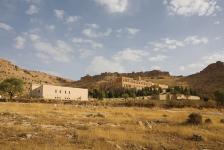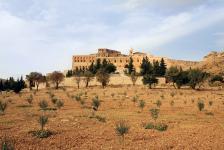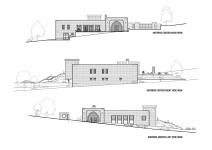Deyrulzafaran Monastery was originally built as the temple of the Sems, a sun worshiping people, to extend and transform the Purple Stupa Monastery in the 4th century. Since the 25th century the Deyrulzafaran served as a Patriarchal Center for 640 years. This part of Mardin’s countryside is found at the edge of history where Deyrulzafaran Monastery peers out from just beyond.
Although the Visitor Welcome Center is disconnected from the Deyrulzafaran Monastery, it gives visitors a perception of being in one space. Coveting uniformity between the two buildings was important and in turn greatly informed the architectural strategy behind building the Welcome Center. The use of architectural elements such as spatial friction, presence of courtyard, choice of materials, arches and arcades help maintain the Monastery’s historical integrity.
When the building is viewed from a distance, instead of shouting as “I am here,” it prefers to proclaim its’ presence subtly by nestling into the enormous and impressive landscape behind. The stone hallways still echo the remarkable era in which the building was erected. Even despite the amount of foot traffic and movement of the masses that have come and gone through the site over the years, it holds sturdy and hardwearing. Mardin’s characteristic local stone texture is felt everywhere in the design, not just in the temple, but throughout Mardin’s architectural scene as a whole. This is a site where both the sun and the shadow shake hands as one feel warmth through the entrance and cools down on one’s way to the atrium or “iwan” (meaning a domed space recessed from a central hall or court).
2004
2005
Ender Ergün, Cavit Ergün, Erdemir Şenoyar
Favorited 1 times




















